|
Social
News 10/8
Hanoi advised to replan urban zoning to ease traffic
pressure
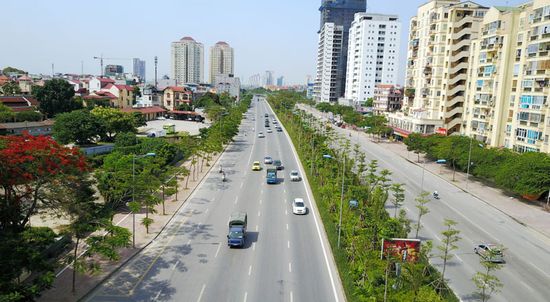
Ring road 2 will reduce traffic load in the center of
the capital.
Traffic congestion is one of the biggest challenges facing Hanoi, especially in the inner city.
Hanoi should focus on strategic planning, including
redesigning urban zoning to give more space available for traffic which has
become much heavier since the city's administrative boundary expansion ten
years ago, experts have said.
Transport expert Nguyen Manh Thang analyzed that when
the boundaries were expanded, Hanoi’s land fund becomes larger, but the
population and means of transport also swell.
Ten years after the expansion of administrative
boundaries, Hanoi's area has increased more than three times, its population
has exceeded seven million and there are nearly six million means of transport
in circulation in the city. Besides, a large number of migrants and vehicles
from neighboring provinces add pressure on the city's road network.
Land, human resources, economy are the conditions to rearrange the space, urban architecture, traffic development, but the results are still limited. Meanwhile, the impact of population growth and transportation growth has become a headache in Hanoi, said Thang.
Given narrower land fund, Hanoi needs to aim to develop
underground space and stretch the traffic density outside the city’s center
to reduce traffic pressure, Phan Truong Thanh, an expert in urban management,
suggested.
To radically solve the traffic jam problem, Hanoi
should combine the two groups of "hard" and "soft"
solutions, Thanh said.
"Soft" solution is to use both administrative
and economic measures to curb the rise and gradually reduce the use of
personal vehicles, while encouraging dwellers to use public transport, Thanh
added.
Restriction of personal vehicles not only helps
increase the traffic space, but also limits traffic congestion and protects
the environment, Thanh emphasized.
In addition, there should be solutions to redesign the
overall architecture, expand the traffic space through the reduction of urban
density by encouraging people to move to the suburds, Thanh said.
Thanh identified that Hanoi can exploit urban land fund
for transport in two directions. Firstly, for the inner areas, the city
should focus on exploiting underground space with investment, construction of
subway lines, underground parking lots.
Secondly, Hanoi should quickly complete the relocation
of some headquarters of agencies, departments, schools, hospitals out of the
city center.
Many experts also noted that the city needs to quickly
establish satellite towns with technical and transport infrastructure that is
capable of meeting trade, internal and inter-regional connectivity.
These satellite towns play important role in both even
distribution of population density and transport load reduction. They also
have stimulated synchronism and parallel development between the inner and
outskirts of Hanoi, according to experts.
After the ten-year expansion, Hanoi has made strong
breakthroughs, reaching the scale of a civilized and modern city. However, to
sustainably develop, it is necessary to inevitably solve the issue of traffic
jam, expand the traffic space, connect well from inside to outside,
contribute to boosting socio-economic efficiency, experts stressed.
US helps Vietnam strengthen readiness to tackle nuclear
incidents

The US experts instruct practitioners to use radioactive
detectors.
Guided by US experts, the response forces for nuclear
incidents in Vietnam’s central provinces have been trained in knowledge and
skills to deal with nuclear radiation incidents.
Vietnam’s Department of Radiation and Nuclear Safety
under the Ministry of Science and Technology, the US’s Department of Energy
in collaboration with Da Nang city’s Department of Science and Technology on
August 6 organized a training course to help forces in Da Nang and other
central provinces better cop with nuclear incidents.
The training course on radiation treatment solutions and emergency radiological assessment focused on lost radioactive sources or uncontrolled radioactive sources and materials, according to the government portal.
Uncontrolled nuclear material is a particular concern
in causing irradiation to the public or used for bad intentions, criminal
actions, even terrorism.
The training course includes lectures, demonstrations,
practical training and field work with radioactive detectors and low
radioactive sources.
During the training session from August 6 to 10,
trainees from the Steering Committee for responding to nuclear radiation
nuclear accidents, large-scale radiation facilities in Vietnam’s central
provinces will be equipped with basic knowledge of radiation, nuclear and
radiation security threats, control and direction, personal protective
equipment, radioactive contamination detectors and methods of radioactive
source recovery.
A team of experts from the US Department of Energy has
provided the training course with more than 40 radionuclide detection and
response systems, including personal devices, equipment on automobiles,
radioisotope identification equipment and health physiological equipment.
Jaipur Foot Artificial Limb Fitment Camp opened in Phu
Tho
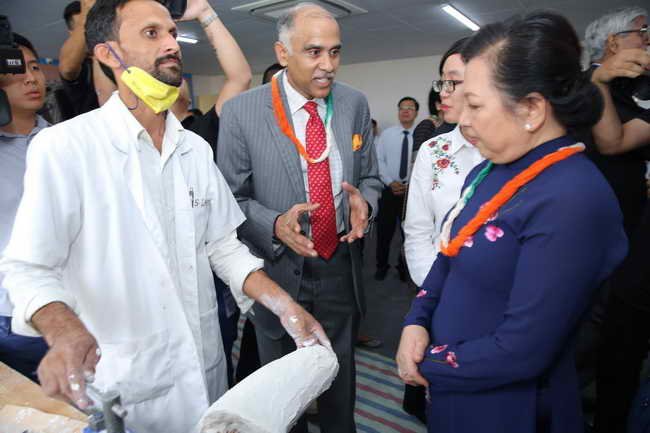
Representatives of the Embassy of
India in Vietnam, BMVSS and Phu Tho Province visit the Jaipur Foot Artificial
Limb Fitment Camp after the opening ceremony
The Embassy of India in Vietnam and the Jaipur-based
non-profit organization Bhagwan Mahaveer Viklang Sahayata Samiti (BMVSS) have
launched the second phase of the Jaipur Foot Artificial Limb Fitment Camp in
Phu Tho Province.
The opening ceremony was attended by Indian Ambassador
to Vietnam Parvathaneni Harish, Vice President of Phu Tho Province People’s
Council Duong Hoang Huong, and representatives of the provincial departments
of Health, Foreign Affairs, and Labor-War Invalids-Social Affairs.
According to Duong Hoang Huong, the project is
implemented under the India-Vietnam Joint Statement issued during Vietnamese
President Tran Dai Quang’s visit to India in March 2018.
He asked the provincial Department of Labors, Invalids
and Social Affairs, the Department of Foreign Affairs, Phu Tho Province
General Hospital and related departments and units in the province to closely
coordinate with the Embassy of India and the sponsors to successfully
organize the artificial limb fitment camp.
Speaking at the opening ceremony, Indian Ambassador
Parvathaneni Harish said the idea of organizing those fitment camps for the
disabled was raised up and supported by Vietnamese first lady Nguyen Thi Hien
when she visited the Jaipur Foot Center of the BMVSS and expressed her desire
to have the same camp in Vietnam.
Parvathaneni Harish said the Indian Government is very
happy when Vietnam becomes the first foreign country to have the Jaipur Foot
Artificial Limb Fitment Camp under an agreement signed by the Ministry of
Foreign Affairs of India and BMVSS in November 2017.
In the first phase, 267 people with disability had
benefited from the project. In this second phase, over 500 people with
disability will be provided with artificial limbs, and Phu Tho Province
General Hospital has been selected as the field site for the fitment camp.
In addition to providing equipment, technicians,
doctors and medical staff during the 20-day camp, the hospital will be
responsible for organizing and monitoring periodic health check-ups for the
people who get prosthesis in the camp.
Founded in 1975, BMVSS is now the world's largest
organization for the handicapped in terms of fitment of artificial limbs and
calipers.
BMVSS has rehabilitated more than 1.55 million amputees
and polio patients by fitting and providing artificial limbs, calipers, and
other appliances, mostly in India and also in 27 countries across the world.
Australia donates water treatment systems to rural
areas
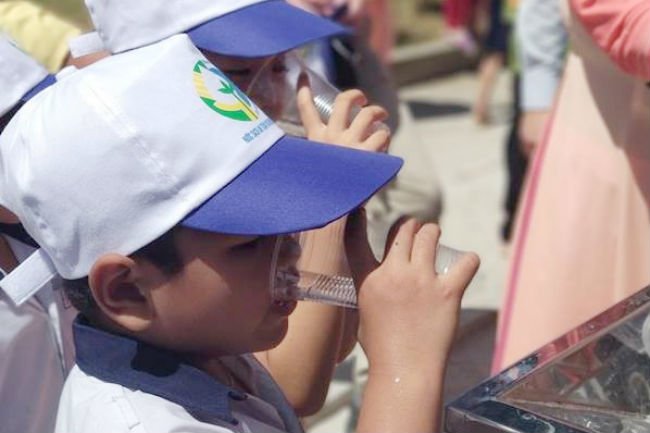
From now on, students at My Hoa 1
Primary School in Dong Thap Province can drink water right from the tap
The Australian Government has donated water treatment
systems to schools in several remote areas in Dong Thap, Khanh Hoa and Son La
provinces to provide safe drinking water to rural communities.
The provision of safe water contributes significantly
to the realization of the right to education. Children that drink unsafe
water are at high risk of getting ill and, therefore, leaving school,
according to the Australian Embassy in Vietnam.
Specifically, Australia has supported the installation
and handover of a water kiosk that will provide clean tap water to teachers
and school children at My Hoa 1 Primary School in Thap Muoi District, Dong
Thap Province.
The system features low-cost technology from Australian
companies and the private sector’s participation to deliver clean water to rural
communities. The project was facilitated by the Australian Water Association
in partnership with the Dong Thap provincial government.
The launch ceremony on August 2, 2018 also had an
Australian-supported water delegation from Cambodia coming to learn about new
technologies that can be applied in the neighboring country.
The Australian Government also plays a supporting role
in facilitating the exchange of expertise between the Australian, Vietnamese
and Cambodian water sectors.
The Australian Water Association, with funding from the
Australian Government, had earlier piloted the use of SkyJuice
ultrafiltration membrane technology in Chieng Mai Commune, Son La Province.
Water kiosks which can provide up to 10,000 liters per
day have been installed at Chieng Mai Primary School and Chieng Mai People’s
Committee community hall to provide safe drinking water to the Chieng Mai
population (around 4,700 people).
Due to the high construction costs involved with piping
water long distances to a small number of customers, it is not easy to
provide piped water to rural population in the remote mountainous areas.
Rural people usually use non-treated stream water in
gravity systems or buy bottled water for drinking. However, water from local
streams often doesn’t meet the standard of quality for drinking set by the
Ministry of Health.
The SkyJuice technology is capable of solving these
problems as it is low cost and easy to operate and maintain.
Australian technology has also helped improve the lives
of teachers and students at Le Van Tam Primary School in Khanh Vinh District
of Khanh Hoa Province, where teachers and students at the school had never
had access to safe drinking water directly from their taps. This is now made
possible thanks to an Australian produced SkyHydrant unit that can treat
ground water using chemical-free filtration.
International conference held to celebrate 25th
anniversary of Rencontres du VN
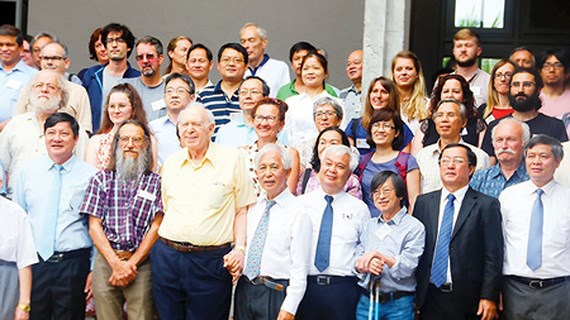
Scientists and young people taking
part in an international conference in the ICISE, located in Quy Hoa Valley
The international conference ‘Windows on the Universe:
25th Anniversary of the Rencontres du Vietnam’ was held yesterday in Quy Nhon
City of the central province of Binh Dinh. The conference was organized by
the Rencontres du Vietnam in the International Center for Interdisciplinary
Science and Education (ICISE), located in Quy Hoa Valley of the city.
On behalf of the Rencontres du Vietnam, Professor Tran
Thanh Van reported that in the last 25 years, the organization has held 5
scientific conferences in Hanoi and one in Ho Chi Minh City. Since 2011, it
has continuously hosted many more international conferences in Quy Nhon City,
welcoming over 4,000 international professors, doctors, and scientists. The
main aim of the ICISE is to offer opportunities for scientific exchanges
between local scientists and their foreign counterparts.
According to Prof. Jacques Dumarchez, representative of
the organization board of Rencontres du Vietnam, thanks to the Rencontres de
Moriond, he had a great chance to meet Prof. Tran Thanh Van and his wife.
Admiring the devotion of the couple for international science and for
Vietnamese one in particular, he agreed to contribute to the building of a
similar model in Vietnam.
Prof. Dumarchez also shared that to help the ICISE
reach new heights, they will need to organize more scientific conferences and
to welcome more international scientists so that the domestic counterparts
can keep in touch with latest knowledge and broaden their horizons. Despite
expected difficulties, he insisted that he wholeheartedly supported Prof.
Van’s work since it was such a meaningful project.
As said by Prof. Dam Thanh Son from Chicago University
of the USA, representative of scientists in the field of Particle Physics,
since 1993, there have been positive changes in the position of Vietnam in
the international ranking chart, signaling a great improvement of physics
knowledge in Vietnam. Our country now possesses a fast growing economy,
providing more chances for physics students to study abroad.
Prof. Son commented that despite the good news, Vietnam
still needs more research institutes and universities of international level.
The ICISE is an excellent model that offers hopes for a brilliant future for
scientific development in Vietnam.
Mr. Pham Cong Tac, Deputy Minister of Science and
Technology affirmed that in the last 25 years, the Rencontres du Vietnam has
enormously contributed to the scientific development in Vietnam.
10 years ago, the nation created a special fund for
this development. Recently, the Prime Minister has also approved many
research projects on physics, mathematics, and other basic science subjects
like chemistry, earth science, ocean science. This means that the Vietnamese
government always pays great attention to scientific research and
development.
Taking part in the event were 180 scientists from 30
nations in the world, including Professor Jerome Friendman from the
Massachusetts Institute of Technology, Nobel winner of Physics in 1990.
In a related event, the groundbreaking ceremony of the
Proscience Hotel was held yesterday in Area 2, located in Ghenh Rang Ward of
Quy Nhon City, next to the ICISE.
The hotel, invested by Proscience Ltd. Co. with Tieu
Nhu Phuong as its representative, will have a surface area of 1.36ha, with 124
rooms. It is designed and consulted by architect Milou from France. The hotel
is supposed to be in use in 2020.
According to Professor Tran Thanh Van, this is a
non-profit hotel to support scientific activities in the ICISE.
Binh Dinh Province aims at building scientific
–educational urban area
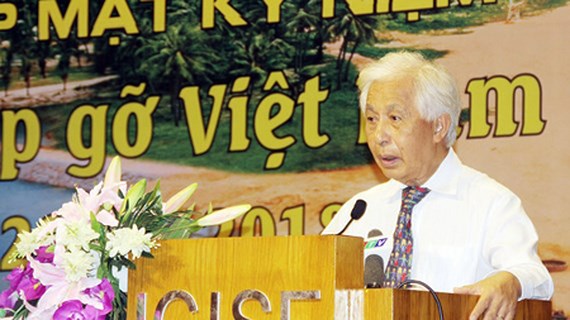
Professor Tran Thanh Van, Chairman
of the Rencontres du Vietnam, is delivering his speech at the anniversary
The Rencontres du Vietnam cooperated with the central
province of Binh Dinh to organize the 10th anniversary of Rencontres du
Vietnam in the province. The event was held on August 5 in the International
Center for Interdisciplinary Science and Education (ICISE), located in Quy
Hoa Valley of Ghenh Rang Ward in Quy Nhon City of Binh Dinh Province.
All participants, consisting of domestic leaders,
professors, and scientists, reviewed past activities of the organization as
well as showed appreciation to Professor Tran Thanh Van and his wife, who
have ignited the passion of science in the area.
According to Prof. Tran Thanh Van, the ICISE has held
40 supreme international conferences and managed 16 scientific schools. It
has welcomed more than 3,500 scientists globally, including 12 Nomel winners,
2 Fields winners, 2 Kavli winners (a high-leveled award in the field of
astronomy), 1 Shaw winner, and 1 Kalinga winner.
Besides the series of conferences, thanks to its close
collaboration with the International Institute of Science, the ICISE has
begun constructing the Institute of Scientific Research and Interdisciplinary
Education.
At the moment, the center has two young research teams
on astrophysics, theoretical physics, and neutrino physics. In the upcoming
time, the center is going to establish more research groups for other fields.
“We have already had stable scientist teams who have
strong connections with domestic as well as international networks. It is
these people who will feed the fire for a sustainable development of the
ICISE”, affirmed Prof. Van.
Expressing his special thanks to his spouse, Prof. Le
Kim Ngoc, and showing his appreciation to the support from the government and
the local authorities in Binh Dinh Province, Prof. Van promised that he and
his team will try their best to transform Quy Hoa Valley into one of the most
attractive areas for scientific activities in the nation and to make Quy Nhon
City the scientific pearl of Vietnam.
Mr. Phan Thanh Binh, Chairman of the Culture, Education,
Youth and Children Committee, commented that after 10 years, the ICISE has
achieved many positive results. He also announced that there was much to do
to turn Quy Nhon City into a scientific center of Vietnam where there would
be high-quality researches and high-level scientists. He hoped that the area
would become a place to professionally train scientists and create a team
that can win a Nobel Prize.
Chairman of the Binh Dinh Province People’s Committee
Ho Quoc Dung showed his appreciation to what Prof. Tran Thanh Van and his
wife have done for Vietnamese scientific development.
In the near future, the province is planning to
transform Quy Hoa Valley into the first scientific – educational urban area
of Vietnam. In this 242-ha area, besides the current ICISE, there will be TMA
Innovation Park, a software park of FPT Software Ltd. Co., a startup village,
an innovative area, a scientific complex with a center for the universe
miniature, a center for scientific discoveries, a public astronomical observatory,
many scientific research institutes, and a school to train high-quality
engineers.
Bac Kan province works to digitalise ancient documents
of local minority groups
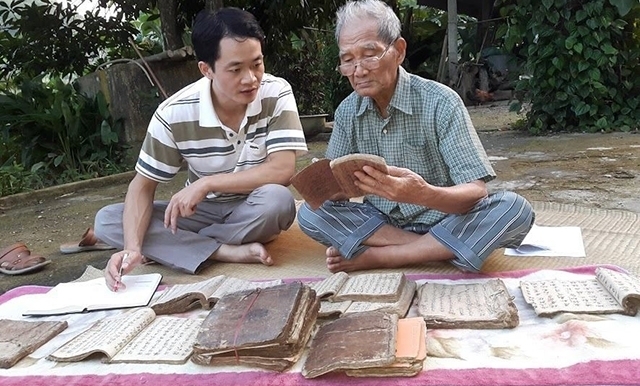
Writer Nong Viet Toai (R) is among
few men who can read and thoroughly grasp the contents of ancient documents
in Bac Kan province
The northern mountainous province of Bac Kan is home to
seven ethnic groups, most of them being minority tribes, communities of which
have preserved cultural heritages for generations, particularly ancient
documents, bibliographies, antiques and relics. Over recent years, the local
authorities have taken proper measures to collect and digitise the documents
for preservation and promotion.
The ancient bibliographies in Bac Kan has been handed
down from generations to generations, many of them being hundreds of years
old. The documents record the traditional rites of passage, such as the ‘cap
sac’ rite, which is held to declare the coming-of-age of Dao men within the
community, ceremonies to pray for peace and bumper crops, and funerals.
Each ethnic group in Bac Kan has their own
bibliography, which are kept in different families as one handwritten copy.
The guardians of the ancient documents are elders and
patriarchs of the families in the village, who are masters of ancient
languages and transcripts and experienced in traditional ceremonies.
A majority of the documents were written in Han
(Chinese script) and Nom (Vietnamese ideographic script); however, the number
of those who are fluent in the scripts is becoming fewer in the village as
many of the guardians have grown old and passed away.
For example, there is now nobody in Vi Huong commune,
Bach Thong district who can read and understand the ancient transcript
engraved in the local bell.
The family of Be Dinh Giai, an old Tay ethnic man in
Bann Nhi hamlet, Bang Lang commune, Cho Don district, now possesses three
bibliographies, including a collection of 80 wedding poems, a collection of
100 Then folk songs for ceremonies to dispel bad luck, and Tong Tran – Cuc
Hoa and Pham Tai – Ngoc Hoa folk stories, which have been preserved since
1913.
According to Giai, his family consider the books a
valuable treasure, which reflect the ritual practices of Tay ethnic people,
but only the elders can thoroughly understand the contents.
Many other ancient documents with a high degree of
erudition written in Han and Nom scripts are being preserved by families at
remote areas.
Trieu Xuan Hoa, a Dao ethnic man in Vi Huong commune,
Bach Thong district, is the seventh generation of guardians of ‘Cho Shong’, a
book of the Dao people’s ethical lessons.
The book teaches the moral standards and code of
conduct that Dao people should be equipped with in life, from simple gestures
of walking, speaking, and standing to the acts of supporting elders and
children.
However, as the book was written in Nom script, few
people can read it, thus youngsters in the community are less in favour of
studying the book, which is now kept for display.
Trieu Quang Phuc from Quang Bach commune, Cho Don
district worried that most of the men who can read and understand the
ancestors’ ancient documents are becoming older, thus the collection and
preservation of the documents is necessary to help younger generations learn
more about the traditional rituals and practices.
Being fully aware of the situation, Bac Kan provincial
People’s Committee recently invested VND250 million for the provincial
library to collect and digitise the ancient documents in the locality.
With sponsorship from the Bill and Melinda Gates Fund,
the provincial library has been facilitated with a server, projector,
scanners, cameras, 40 computers and peripheral devices to help in taking
photos, scanning and digitising the documents.
So far, the library staff members have collected 88
objects, and 64 ancient bibliographies with nearly 3,500 pages. The collected
documents are of varied materials of cloth, wood, do (poonah) paper, and
metal, and are transcribed in assorted languages, patterns and symbols.
According to Deputy Director of the provincial library,
Mai Thi Nga, further research has been carried out on the origins, practice
and development of the customs of ethnic groups in Bac Kan as well as their
spiritual and cultural life.
The data is formatted and backups are regularly created
with digital library software, creating a source of information and
communication for future research.
The library leaders have also take measures to
translate the collected documents to popularise the content of the documents
among the public, helping to raise their awareness of the treasured tangible
heritages of the ancestors.
Waste Land documentary to be screened at The Learning
Hub
In its fifth Meaningful Movie Night program, The
Learning Hub in Hanoi’s Hoan Kiem District will present Waste Land
documentary on August 13, from 7:30 p.m. to 10 p.m.
Co-directed by Lucy Walker, Karen Harley, the
documentary takes viewers to the outskirts of Rio de Janeiro where the
biggest landfill site in the world is located.
This really looks like an alien landscape, and
certainly not a place where anyone would want to visit in any period of time.
However, many people have seen an opportunity in the garbage and make a
living by sifting through it and finding things which may be of value.
The 2010 Waste Land film follows a number of women and
men who make a living of the landfill to get a picture of their lives and
learn who they are. The star and writer of the documentary, Vik Muniz, wanted
to highlight the beauty of the human spirit in times of extreme hardship.
Filmed over nearly three years, Waste Land shows how
renowned artist Vik Muniz journeys from his home in Brooklyn to his native
Brazil and the world’s largest garbage dump, Jardim Gramacho, located on the
outskirts of Rio de Janeiro.
There he photographs an eclectic band of “catadores” --
self-designated pickers of recyclable materials. Muniz’s initial objective
was to “paint” the catadores with garbage. However, his collaboration with
these inspiring characters as they recreate photographic images of themselves
out of garbage reveals both the dignity and despair of the catadores as they
begin to re-imagine their lives.
Ticket price for the screening is VND20,000, including
some snacks, The Learning Hub announces on its Facebook fan page.
Photo contest on Vietnam – Japan friendship kicks off
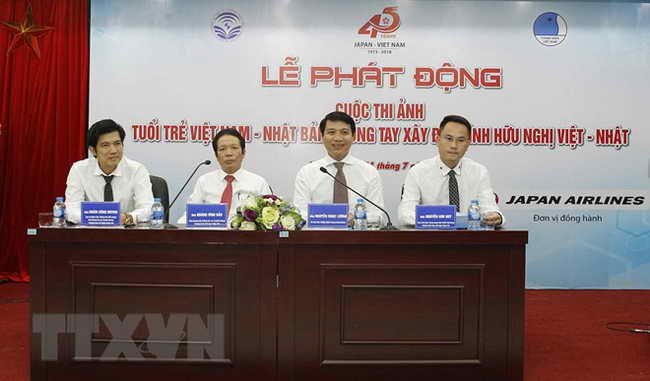
A ceremony is held on July 31 to
announce the photo contest
On the occasion of the 45th anniversary of diplomatic
ties between Vietnam and Japan, the Ministry of Information and
Communications and the Central Committee of Vietnam Communist Youth
Federation launched a photo contest themed “Vietnamese and Japanese Youths
Join Hands in Fostering Friendship” on July 31, 2018.
The contest is open to all youths, amateur and
professional photographers and reporters from Vietnam and Japan, with an aim
to promote young people’s understanding of the bilateral ties and friendship
between the two countries as well as give Japanese people a deeper insight
into Vietnam’s land and people in the integration process.
The photos should capture the solidarity, friendship
and cooperation between Vietnam and Japan, diplomatic activities, cultural
exchanges, economic and political events taking place in both countries,
beautiful images of the land, peoples, customs, and the special cultural
characteristics and socio-economic achievements of the two nations.
Each photo must have a caption written in Vietnamese
and Japanese or English to describe the featured event and characters.
Criteria to pick out the best photos include the
photo’s content which represents the relationship between Vietnam and Japan,
originality, humanistic sense, emotional connection and significant impacts
on the society.
The contest offers one first, two second, five third
and five consolidation prizes with total prize money of VND90 million,
according to the Vietnam News Agency.
Photos should be sent to the Central Committee of
Vietnam Communist Youth Federation office at 64 Ba Trieu Street, Hoan Kiem
District, Hanoi and to cuocthianh45namvietnamnhatban@gmail.com no later than
September 30, 2018.
First plogging event takes place in Hanoi
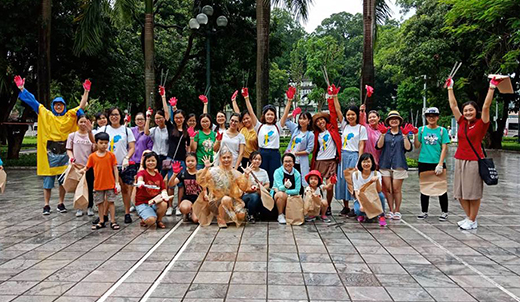
Participants in the first plogging activity in Hanoi. Photo:
Swedish Embassy in Hanoi
Plogging (jog and pick litter) - a fresh Scandinavian
fitness trend - has made its way to Hanoi for the first time.
The Sweden Alumni Network Vietnam (SANV) on August 5, 2018 proceeded with the first plogging event in Hanoi despite heavy rain, helping raise awareness of locals in environmental protection. The ploggers passed by a number of streets such as Thanh Nien, Hoang Dieu and Quan Thanh. After that they joined a fika – the Swedish traditional tea-break - at The Bluebird’s Nest café in Dang Dung street, which is one of the first plastic straw free coffee shops in Hanoi, to share their first time plogging experience, talk about plastics and hear some tips to live with zero waste as well as figure out the best way for plastics use. In his message to the participants of the event, Swedish Ambassador Pereric Högberg stressed that it is a brilliant idea to organize the first plogging in Hanoi. “As a committed runner, I have always picked up trash along my running path for about 30 years. What a nice action to keep the sidewalks and public areas clean and tidy for your children, your neighbors or the ones who jog or walk after you and to make Hanoi a better living place for all".
Plogging is a combination of “jogging” and “picking”
popularly practiced by Swedish exercisers who feel not right seeing trash on
their route but not picking up while jogging. Unlike previous garbage picking
events, this “rubbish way to get fit” has spread out to other countries in
Europe and making its way to U.S and Thailand thanks to social media.
Besides the encouragement for fitness activities, this event is to raise awareness of citizens about plastics usage. “We aim to convince people that we must reduce the consumption of plastic bags, single use plastic containers which are excessively disposed into our environment. We can also clean our street, campus by exercising,” said Hao Le, a Sweden alumnus. In April 2018, the first fika discussing organic food was held along with the campaign “7 Day Challenge” launched by the Embassy of Sweden in Hanoi with the United Nations and Live&Learn as partners. SANV wanted to deliver a message to its members to promote organic habit, acknowledge the massiveness of classification around us, in the lake, the river, in the ocean effecting marine life underneath.
VNN
|
Thứ Sáu, 10 tháng 8, 2018
Đăng ký:
Đăng Nhận xét (Atom)
Không có nhận xét nào:
Đăng nhận xét